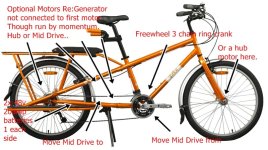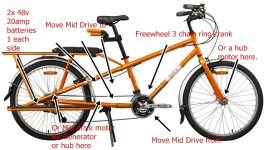c0mpute
100 mW
G'Day,
How, to start this... hmmm
I have a Yuba mundo cargo bike and would like to know a bit more about cyclone and gng models of motors..
Idea is to have one motor with a double free wheel cog (acting as a generator) so that when pedaling backwards, you can do so freely..
have a second motor sitting above or to the side of the other motor a little back from the original so it only spins the generator.. (freewheel cog)
then have a 3 gear freewheel crank. same ones that come with any kit, just keeping the 3 speeds on it...
So some questions come to mind which are..
Has anyone tried or know if a cyclone double freewheel cog will fit on a 48V gng motor? say 500w brushless for arguments sake..
Does anyone know if a gng motor can use or is compatible with a conhismotor 48v 20amp hour programmable controller? I like the way i can set the speed with the digital read out and programmable display.
Does anyone know where i could get a bracket made to fit the normal Mid drive motors up the front of the back wheel, where two bolts sit to hold side railings and two bolts in front where the stand sits.. or even hold onto the side of the bike frame?..
Does anyone know where i can get a 3 gear freewheel crank for a UG51 chain set that Yuba uses on their bikes?
Apology btw.. I am not really a hobbyist. i am just trying to make a bike the i would like it when you have min resources to use (south west sydney is not the best place for ebike stores) ..
Thanks for your interest in this post..
Cheers..
Ps, I forgot to mention that two motors could come in handy if one decides to break down. using the generator as a motor if needed.. hwhich is also part of the idea...
How, to start this... hmmm
I have a Yuba mundo cargo bike and would like to know a bit more about cyclone and gng models of motors..
Idea is to have one motor with a double free wheel cog (acting as a generator) so that when pedaling backwards, you can do so freely..
have a second motor sitting above or to the side of the other motor a little back from the original so it only spins the generator.. (freewheel cog)
then have a 3 gear freewheel crank. same ones that come with any kit, just keeping the 3 speeds on it...
So some questions come to mind which are..
Has anyone tried or know if a cyclone double freewheel cog will fit on a 48V gng motor? say 500w brushless for arguments sake..
Does anyone know if a gng motor can use or is compatible with a conhismotor 48v 20amp hour programmable controller? I like the way i can set the speed with the digital read out and programmable display.
Does anyone know where i could get a bracket made to fit the normal Mid drive motors up the front of the back wheel, where two bolts sit to hold side railings and two bolts in front where the stand sits.. or even hold onto the side of the bike frame?..
Does anyone know where i can get a 3 gear freewheel crank for a UG51 chain set that Yuba uses on their bikes?
Apology btw.. I am not really a hobbyist. i am just trying to make a bike the i would like it when you have min resources to use (south west sydney is not the best place for ebike stores) ..
Thanks for your interest in this post..
Cheers..
Ps, I forgot to mention that two motors could come in handy if one decides to break down. using the generator as a motor if needed.. hwhich is also part of the idea...



